The Incomplete Wolverine – 2000
Part 1: Origin to Origin II | Part 2: 1907 to 1914
Part 3: 1914 to 1939 | Part 4: World War II
Part 5: The postwar era | Part 6: Team X
Part 7: Post Team X | Part 8: Weapon X
Part 9: Department H | Part 10: The Silver Age
1974-1975 | 1976 | 1977 | 1978 | 1979
1980 | 1981 | 1982 | 1983 | 1984 | 1985
1986 | 1987 | 1988 | 1989 | 1990 | 1991
1992 | 1993 | 1994 | 1995 | 1996 | 1997
1998 | 1999
When we left off, Wolverine was a brainwashed henchman of Apocalypse under the name “Death”, and he had replaced by a Skrull impostor for several months. And now, the thrilling climax… right?
 CABLE vol 1 #75
CABLE vol 1 #75
“Who is Worthy to Break the Seals…?
by Joe Pruett, Rob Liefeld, Lary Stucker & Optic Studios
January 2000
We’re now in the Apocalypse: The Twelve crossover. Cable has been captured by Apocalypse. He escapes, fights Death, and then confronts Apocalypse himself – but has to surrender again when Apocalypse threatens to have Death kill Caliban. That’s pretty much the whole anniversary issue, which is built around two big fight scenes. It tries to rekindle the idea of an age-old rivalry between Cable and Wolverine, something that had long since been moved on from.
X-MEN vol 2 #96
“The Gathering”
by Alan Davis, Mark Farmer & Marie Javins
January 2000
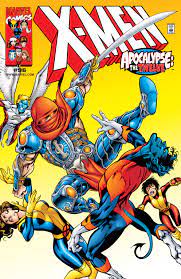 More of Apocalypse: The Twelve. The Twelve was a long-running subplot about twelve mutants who supposedly going to be of great historic important. It was set up as a really big deal. This crossover is the pay-off, and they turn out to be just a bunch of characters with convenient powers for a particular scheme that Apocalypse had in mind.
More of Apocalypse: The Twelve. The Twelve was a long-running subplot about twelve mutants who supposedly going to be of great historic important. It was set up as a really big deal. This crossover is the pay-off, and they turn out to be just a bunch of characters with convenient powers for a particular scheme that Apocalypse had in mind.
As part of his scheme to assemble the Twelve, Apocalypse sends Death to abduct Mikhail Rasputin from the X-Men Mansion. Death duly punts him through a portal to Apocalypse’s base, but makes his own escape the conventional way. He fights past the X-Men (oh, and Skrull informant Fiz) and ignores all their attempts to talk to him. But Kitty argues that Wolverine was actually trying to thwart Apocalypse’s plans, since he was trying to kill the X-Men – including Cyclops, who’s a member of the Twelve. If you say so, Kitty!
In both these issues, Death is written as a Wolverine who has embraced his role as a Horseman, in contrast to earlier chapters where he was written as muddled. He knows who he is here, and he has his normal speech patterns. It’s more consistent with how other Horsemen have been written while serving Apocalypse. In the next issue, we’ll be back to writing him as addled and confused. There’s a real lack of co-ordination here, on a very basic plot point.
 WOLVERINE vol 2 #146-147
WOLVERINE vol 2 #146-147
“Through a Dark Tunnel” / “Into the Light”
#146 by Fabian Nicieza, Erik Larsen, Mike Miller, various inkers & Marie Javins
#147 by Fabian Nicieza, Erik Larsen, Roger Cruz, Derek Fridolfs, Andy Queens & Wilson Ramos
January & February 2000
We’re still in Apocalypse: The Twelve. Fleeing the Mansion, Death heads into the Morlock tunnels. Some of the X-Men come after him, while the rest of the team goes to deal with Apocalypse. The tunnels trigger some memories, and the X-Men manage to break Apocalypse’s control and bring Logan’s regular personality back to the fore. Then Angel’s wings turn to light for some reason. They feel like “getting stabbed by the truth”, apparently. Angel seeks out the hospitalised Abraham Kieros (the guy who served as War in the first published line-up of the Apocalypse’s Horsemen) and uses his new energy to cure the guy. Logan and Angel then agree that, as former henchmen of Apocalypse, they will have to redeem themselves one day at a time.
There’s a nice bit where Shadowcat fails to get through to Wolverine, but Jubilee makes the headway instead. For the most part, though, this is either forgettable or impenetrable. It seems to be setting up an idea that Wolverine will have to strive to redeem himself after his time as Death, but nothing will come of that.
 UNCANNY X-MEN vol 1 #377
UNCANNY X-MEN vol 1 #377
“The End of the World as we Know It”
by Alan Davis, Terry Kavanagh, Tom Raney, Scott Hanna & Brian Haberlin
February 2000
Another Apocalypse: The Twelve tie-in. Wolverine only appears on the last page, along with the X-Men who came after him. He’s back in his regular costume, and seems to be acting completely normally.
So obviously, these X-Men will now race off to join their teammates in the final showdown against Apocalypse. Right?
Wrong! A hacker is downloading highly sensitive data from the X-Men’s computers. This simply must be dealt with at once! And so…
X-51 #7-8
“The Harder They Fall” / “Aftermath”
by Karl Bollers, Joe Bennett, Bob Wiacek & John Kalisz
February & March 2000
The hacker is Machine Man, who has been infected by Sentinel nanites that forced him to steal the data. The X-Men show up to fight him. Since the nanites stop him explaining himself, Machine Man eventually blows himself up, and the X-Men leave without ever finding out what was going on.
Really. We diverted from a major storyline for that.
So, back to the big story. Right?
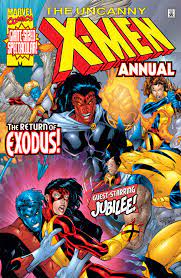 UNCANNY X-MEN ANNUAL 1999
UNCANNY X-MEN ANNUAL 1999
“Utopia Perdida”
by Ben Raab, Anthony Williams, Troy Hubbs, Scott Koblish & Colorgraphix
1999
Wrong!
The group do at least try to join the main plot – Wolverine spends the journey sitting at the back of the plane and meditating in the nude, because why not? But the group get diverted yet again, this time by a distress call from Genosha. Wolverine is the one who insists on going for Genosha over Apocalypse, the idea being that he’s gone straight back to looking for an excuse to kill Magneto – which is at least a decent character reason for him to change course. And indeed, as soon as they land, he completely ignores the distress signal and stalks off in search of his archenemy.
It turns out that Exodus is now running the country, posing as Magneto, and that he’s trying to impose a utopia by mind control. Naturally, the result is worse than ever, and the X-Men defeat him.
Okay. So… now we’re going to go and join in the showdown with Apocalypse, right?
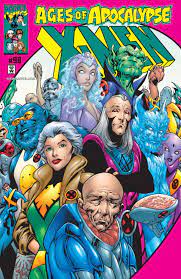 X-MEN vol 2 #98
X-MEN vol 2 #98
“First & Last, part 2”
by Alan Davis, Terry Kavanagh, Mark Farmer & Marie Javins
March 2000
Still wrong!
The storyline climaxes with “Ages of Apocalypse”, a crossover in which Apocalypse traps the characters around him – the Twelve and the other half of the X-Men – in a pocket universe. There, they live out their lives in an artificial timeline where Xavier’s dreams thrive. But it’s all a trick to get the X-Men to power up a device that will supposedly save Professor X’s life. In fact, when they do, Apocalypse will harness their energies to achieve cosmic ascension. The X-Men see through it in the end, but Apocalypse escapes (in Cyclops’ body).
Wolverine only appears in the epilogue, which simply notes that he “seems to be recovering completely from his ordeal as Death”. So after all that – after a storyline that gives him his adamantium back and takes him out of his own book for months – he misses the big finale. He never confronts Apocalypse. And he’s just fine.
He’s just fine.
Oh yes… Wolverine vol 2 #148. It’s an “Ages of Apocalypse” tie-in, in which the New Fantastic Four (Wolverine, Hulk, Ghost Rider and Spider-Man) have an adventure in the Negative Zone. The problem is that, as mentioned, the only real people in “Ages of Apocalypse” are Apocalypse himself and the small group of characters that he’s manipulating. None of them are in Wolverine vol 2 #148, which therefore features exclusively NPCs. Either it’s a truly weird editorial decision, or there was a massive breakdown of communication as to the concept of the event. 1999 gave us several issues of Wolverine with no Wolverine, but issue #148 takes it to the next level – an issue of Wolverine with no anyone.
X-MEN UNLIMITED vol 1 #26 (back-up strip)
“Full Circle”
by Matt Nixon, Toby Cypress & Joe Rosas
March 2000
Back to business as usual. Logan stops mad scientist Professor Gibbon from abducting a child to cyberspace. This story is missing from the Marvel Unlimited version of the issue.
X-MEN UNLIMITED vol 1 #35 (back-up strip)
“Unhappy Anniversary”
by Jimmy Palmiotti, Amanda Connor & Paul Mounts
April 2002
Logan is at a backwoods strip club when Rogue (whose story it is) shows up in pursuit of some obnoxious guys who ran her off the road. After ostensibly hilarious stripper-related shenanigans, Logan finds out that Rogue has borrowed his bike and totalled it. Painfully unfunny, but at least Connor can draw this stuff. It takes place way out of publication order since Professor X, Rogue and Wolverine are all at the Mansion.
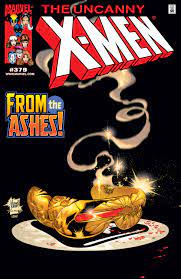 UNCANNY X-MEN vol 1 #379
UNCANNY X-MEN vol 1 #379
“What Dreams May Come…”
by Alan Davis, Tom Raney, Scott Hanna & Brian Haberlin
April 2000
Mourning the loss of Cyclops, Professor X returns to space with some mutant Skrulls that he’s going to mentor. (They eventually get named Cadre K.) The High Evolutionary then declares mutants to be an unacceptable threat to the planet. The powers of “a few hundred” individuals are outweighed by the right of billions of ordinary people to live in peace, he says. So he removes the powers of all mutants everywhere.
And yes, it’s only another year before we’ll be told that the number of mutants is in the millions. The numbers here seem too low even for 2000, though, bearing in mind that Genosha alreaady exists as a mutant nation in some form.
WOLVERINE vol 2 #149
“Resurrection”
by Erik Larsen, Graham Nolan, Jimmy Palmiotti & Marie Javins
April 2000
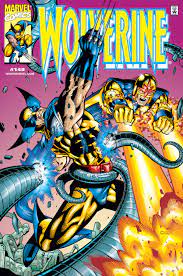 The rest of the X-Men have resigned themselves to being normal humans, but without his healing factor, Logan’s adamantium is poisoning him.
The rest of the X-Men have resigned themselves to being normal humans, but without his healing factor, Logan’s adamantium is poisoning him.
Ploughing on with the superhero business despite it all, Wolverine investigates a scrapyard which his Skrull impostor had visited in issue #140. He winds up teaming with the New Warriors against Nova villain the Reanimator. The Reanimator is also a mutant with the power to bring robots to life, but since all his robots have been in working order, he’s had no occasion to use his powers lately, and hasn’t noticed that they’re gone. The heroes beat him.
And that’s the end of the Erik Larsen run. It’s absolutely plagued by crossovers, barely gets to use its lead character, and never manages to get any proper storylines going. The issue wryly nods to the fact that the Reanimator’s long term goals were never revealed.
X-MEN vol 2 #99
“Oh, the Humanity!”
by Alan Davis, Terry Kavanagh, Brett Booth & Hi-Fi Design
April 2000
The X-Men have been without their powers for weeks. Wolverine, still in costume and heavily bandaged, appears briefly – he rescues Jubilee from muggers, and then announces that he’s going to find Sabretooth for a final showdown. (We never see this, so presumably they couldn’t find one another.)
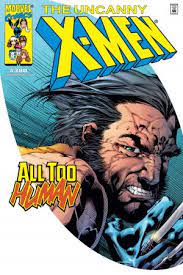 UNCANNY X-MEN vol 1 #380
UNCANNY X-MEN vol 1 #380
“Heaven’s Shadow”
by Alan Davis, Terry Kavanagh, Tom Raney, Scott Hanna & Brian Haberlin
May 2000
The Evolutionary’s power-suppression rays are dangerously accelerating evolution, so the depowered X-Men set out for his satellite HQ to stop him. As soon as they’re aboard, and on the other side of the projectors, their powers return. It turns out that the Evolutionary is being manipulated by Mr Sinister, who makes a run for it on being exposed. The Evolutionary realises his mistake and destroys his anti-mutant equipment himself. Everyone gets their powers back.
Viewed from the standpoint of 2022, what’s remarkable about this arc is that the X-Men largely accept the loss of their powers as a bit of a relief. Wolverine claims in this issue that he wanted to see Rogue and Marrow in particular freed from their cursed powers. Of course, “powers as curse” is a standard Marvel trope, but it’s one the X-Men will soon move away from as the idea of mutant identity and mutant culture comes to the fore. It’s not completely absent from this arc, but it’s certainly marginal.
That ends the Alan Davis run, which holds up better than you might expect. It’s solidly told stories, for the most part.
So, time for another relaunch – 2000’s “Revolution”. This one was built around the return of Chris Claremont to the X-Men titles. It was the year that the first X-Men movie came out, so there was an obvious appeal in being able to say that Claremont was back on the books. That’s also why some of this year’s issues have a bland, movie-style logo – and the covers of X-Men vol 2 #104 and #105 proudly proclaim them to be “The Comic That Inspired X-Men The Movie.”
“Revolution” didn’t work out, and didn’t last long. Partly that’s because it wasn’t especially good, but partly it was because Bill Jemas and Joe Quesada took over Marvel in 2000, and they had their own very different ideas about what to do with the X-books. But it takes a while for their new direction to filter through to the page, so we’ll come back to that in 2001.
Sticking with “Revolution” for now, there’s a gap in the timeline before the relaunch; the original plan was to go back and fill it in later, but “Revolution” imploded so quickly that the books never got around to it. During this period, the X-Men adopt new costumes, and the new Thunderbird (Neal Shaara) joins the X-Men.
One more thing: Marvel no longer had cover dates on their covers by this point, so it’s as good a place as to switch to using publication dates.
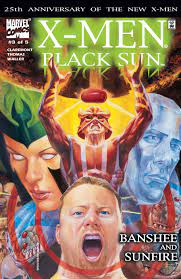 X-MEN: BLACK SUN #3-5
X-MEN: BLACK SUN #3-5
5-issue miniseries
#3 by Chris Claremont, Roy Thomas, Karl Waller & Tom Smith
#4 by Chris Claremont, Louise Simonson, Alitha Martinez, John Stanisci & Tom Smith
#5 by Chris Claremont, Pablo Raimondi, Jason Martin & Tom Smith
September 2000
This miniseries commemorated the 25th anniversary of Giant-Size X-Men #1. It takes place before the first “Revolution” arc, but doesn’t actually fill in the story gaps.
Belasco tricks Kitty into performing a spell that allows five N’Garai to swap bodies with Sunfire, Nightcrawler, Colossus, Storm and Banshee – in other words, the “new” X-Men from 1975, other than Thunderbird (who’s dead) and Wolverine (because “even Belasco is not mad enough to try and ensorcel Wolverine”). A new Magik shows up to help deal with Belasco; she turns out to be Amanda Sefton. The Ru’Tai also appear, as part of their ongoing war with the hated N’Garai.
Wolverine enters the plot in issue #3. He and Iceman are doing reconnaissance in Genosha and are generally disappointed by the apparent success of Magneto’s regime. As usual, Wolverine wants to kill Magneto, and insists that it’s a righteous, moral cause and definitely not a personal vendetta. The possessed Sunfire and Banshee attack, and capture the souls of Polaris and Iceman for use in Belasco’s spell. Wolverine then hooks up with Magik to join the fight. Ostensibly issue #5 is meant to be his spotlight issue, but really, all he does in the rest of the series is to do some fighting in Limbo while Magik and the original X-Men take care of Belasco. Considering the anniversary angle, he’s remarkably sidelined.
A flashback in Wolverine / Hercules: Myths, Monsters & Mutants #1 is placed here on the official timeline – it’s yet another panel of Wolverine attacking Matsuo Tsurayaba, no doubt placed here on the basis that the next story takes place in Japan.
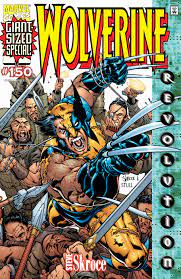 WOLVERINE vol 2 #150-153
WOLVERINE vol 2 #150-153
“Blood Debt”
by Steve Skroce, Lary Stucker & Steve Buccellato
March to June 2000
Logan visits Mariko’s grave again. A drunken Silver Samurai appears, and tells Logan that he regrets becoming Clan leader – the whole operation is so corrupt that Mariko is better off out of it. Logan is naturally unimpressed by this display of self pity. Next, he visits Yukio, who is now living in a rather nicer flat, because she’s got Amiko to look after. But Amiko is growing into a bit of a street brawler, and she’s far too old for the toy that Logan brought her as a present. All good character stuff.
The Yashida Clan has been overthrown by Haan Kaishek of the Kaishek Clan. When Haan’s men come after the Samurai, he and Logan escape with the aid of Haan’s family rivals – his brother Gom Kaishek and their innocent sister Kia Kaishek. Gom uses Amiko and Yukio as hostages to try to force Wolverine to work with him, but gets killed by Haan in short order. Kia then persuades Wolverine to help her reach Haan so that she can negotiate a truce – only to assassinate Haan herself.
Having despatched her siblings, Kia sets off for Mongolia, intending to kill Clan patriarch Yolyn Kaishek and seize control. By the time Wolverine catches up with her, she’s already killed Yolyn and is locked in battle with Yukio, who wants revenge for the kidnapping. Wolverine persuades Yukio to abandon her quest for revenge and focus on her responsibilities to Amiko – but then completely ignores that advice himself, fighting Kia while Yukio has to take care of Amiko. A spark from a clash of blades sets off an explosion which kills Kia. Wolverine survives thanks to his healing factor, and the supporting cast got to safety, but the Kaisheks have wiped themselves out.
This is the best Wolverine story of the year, and it’s not even close. The art is fabulous and the story’s not bad either. Kia’s a fun character, playing off Wolverine’s tendency to be protective towards damsels in distress and to rationalise away obviously suspect behaviour from them. The circle of violence angle isn’t subtle, but it’s well done, and Wolverine completely going against his own advice in the final issue works well.
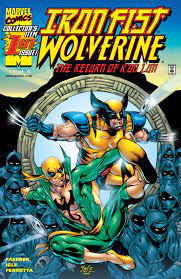 IRON FIST / WOLVERINE
IRON FIST / WOLVERINE
4-issue miniseries
by Jay Faerber, Jamal Igle, Rich Perotta & Liquid!
September to December 2000
Now led by teenager Junzo Muto, the Hand bring K’un-Lun to Earth, taking advantage of a magical ritual that was unwisely started by Iron Fist. As the city starts manifesting in Tokyo, Iron Fist is stuck inside , while Wolverine and other superheroes have to fight their way in. (They also have to deal with objections from Sunfire and the Japanese law enforcement agency Yakiba for some reason.) Even though Luke Cage is right there, but Wolverine implausibly insists that Luke would be too emotionally involved, so heads into K’un-Lun himself to rescue Iron Fist, Misty Knight and Yu-Ti. Never a good sign when your title character is arguing that he should be taking the lead in the plot because it doesn’t have anything to do with him.
Eventually Iron Fist breaks the spell by allowing Yu-Ti to kill him; everything goes back to normal, and the spirits of K’un-Lun’s dead restore Iron Fist to life. Iron Fist then becomes the custodian of K’un-Lun’s Dragon Kings, who remain on Earth in dragon form. As you may have guessed, this is not a Wolverine story. It doesn’t even do anything with his personal connection with the Hand. It exists to tie up a plotline from New Warriors and Heroes for Hire, and Wolverine is just lending some star power to it. The core story isn’t bad, but the numerous guest stars are a distraction, and the whole thing is weirdly dismissive about the Japanese characters.
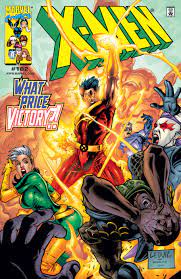 X-MEN vol 2 #102
X-MEN vol 2 #102
“The Cruelest Cut”
by Chris Claremont, Leinil Francis Yu, Mark Morales & Liquid!
May 2000
Claremont’s “Revolution” run began in issue #100, but he doesn’t use Wolverine until the third issue – which seems like a statement of some sort. Wolverine still has his slightly-feral font, by the way, but that’s now the last lingering sign of his animal phase.
Wolverine and Dani Moonstar investigate a series of attacks on Mr Sinister’s bases. They identify the attacker as Domina, leader of the Neo – a hidden race of mutants who are angry about the deaths caused when Sinister manipulated the Evolutionary into switching off their powers. Later, Wolverine rejoins the rest of the X-Men in time for their fight with the Neo. But the X-Men get driven out of the Neo’s stronghold, and Neo member Barbican seals it up, leaving Cecilia Reyes and some Morlocks stuck inside. You’d think that getting them back would be quite urgent, but apparently not, as the X-Men won’t get to it for a while.
 X-MEN vol 2 #103
X-MEN vol 2 #103
“The Goth”
by Chris Claremont, Tom Raney, Scott Hanna & Liquid!
June 2000
Wolverine ambushes Rogue, switches off her powers, and lures her into a Danger Room simulation. It’s all done in order to test her as a leader, and of course she passes the test, and he offers her the job. Rogue is reluctant, but everyone else agrees that she is the best qualified – Wolverine, for his part, insists that he doesn’t have the temperament to be a leader. This is very traditional Claremont Wolverine.
Soon after, Colossus, Archangel and Thunderbird get into a fight with a group called the Goth. Wolverine and the others race to help, but by the time they show up, everyone has vanished.
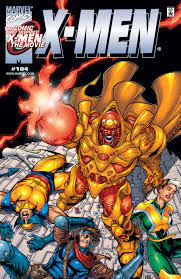 X-MEN vol 2 #104 & UNCANNY X-MEN vol 1 #385
X-MEN vol 2 #104 & UNCANNY X-MEN vol 1 #385
“Painted Ladies” / “Shell Game”
#104 by Chris Claremont, Leinil Francis Yu, Mark Morales & Liquid!
#385 by Chris Claremont, German Garcia, Michael Ryan, Randy Green, Dan Panosian, Andrew Pepoy, Rick Ketcham & Richard Isanove
July & August 2000
The X-Men have uncovered a slaver alliance between the Hong Kong Triads, the Goth and the Crimson Pirates. Rogue opts for a show of force, and leads her team in a bombastic attack on the Hong Kong Hellfire Club, despite its cover as a legitimate gentlemen’s club. They fight Crimson Pirates Killian, Broadside and the Sea Dogs, and their Hound Kymri. Then they face the other half of the X-Men, led by Gambit, who are feigning an alliance with Bloody Bess and Beldane. Wolverine gets knocked out early in the fight and plays no further part, but the X-Men defeat the slavers, including the Goth’s leader, who is confusingly also called the Goth.
We’re now deep in the phase where Chris Claremont was creating large groups of villains who didn’t have much individual personality beyond a codename. At least the Crimson Pirates and the Goth have memorable designs. Anyway, the point of the story is that as leaders go, Rogue and Gambit are reckless but cool.
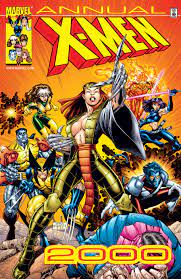 X-MEN ANNUAL 2000
X-MEN ANNUAL 2000
“Mutie.Dead”
by Chris Claremont, Scot Eaton, Scott Hanna & HiFi Design
July 2000
This was the year that the dot com bubble peaked, and so we get a story called “Mutie Dot Dead”. Naturally, it has nothing to do with the internet.
When the X-Men save Lady Deathstrike from Prime Sentinels, she asks the X-Men to help her stop Bastion from activating any more of them. In fact, Bastion is dead, but his activation codes have fallen into the hands of Stryfe. The X-Men and Deathstrike defeat Stryfe, Deathstrike is congratulated on her face turn (which doesn’t stick), and Rogue notches up a win as leader. Since Stryfe is a psychic, Wolverine is pretty ineffective against him, something which happens a lot around this time; you get the sense that Claremont was quite keen to focus on other characters.
For some reason, Deathstrike is now Yuriko Oyama, “head of the world-renowned Oyama Design Group”. It’s also the first time Wolverine appears alongside Tessa (later Sage) since she joined the X-Men at the start of the Claremont run.
X-MEN vol 2 #105
“Killing Angels”
by Chris Claremont, Leinil Francis Yu, Mark Morales, Norm Rapmund, Liquid! & Hi-Fi Design
August 2000
The X-Men battle the Twisted Sisters – Helix, Coil, Gyre, Ringlet and Torque. The heroes win but there’s a lot of property damage. There isn’t much more to it than that.
 X-MEN vol 2 #106
X-MEN vol 2 #106
“Search and Rescue”
by Chris Claremont, Leinil Francis Yu, Thomas Derenick, Anthony Williams, Mark Morales, Rick Ketcham, Norm Rapmund, Liquid! & Hi-Fi Design
September 2000
The X-Men finally get around to attempting a rescue of Cecilia Reyes, who you’ll recall has been stuck in the Neo stronghold since issue #102. Nightcrawler and Wolverine simply teleport inside.
They encounter drug dealer Rufus Delgado, who has been physically bonded to Charlotte Jones, and who is busily pursuing Neo member Elysia through the building. Elysia can make people see what they most desire. For some reason her powers don’t work on Wolverine; she says she can’t sense anything that he desires, but the idea seems to be that he’s so private that he’s much harder to read than his teammates.
The Neo are now blaming the whole outside world for making them lose their powers. Wolverine, Nightcrawler and Elysia try to explain the truth to Domina, but wind up in a huge fight between the rest of the X-Men and more of the Neo (Domina, Ransome Sole, Rax, Junction, Anteus and Salvo – you see what I mean about this period?). During the fight, Wolverine saves Domina from Delgado, and cuts Delgado and Jones free of one another – but Domina takes advantage to knock him out. Ultimately, Domina agrees to reconsider and everyone goes home.
A lot of this issue is spent setting up internal feuds within the Neo, which never go anywhere. There are a number of plot problems, too. If the Neo think the whole world was responsible for the attack on them, how did they know to go after Sinister in issue #102? And after the Neo went to all the trouble of using Barbican’s powers to keep people out of their citadel, why on earth do they answer when the X-Men simply knock on the door?
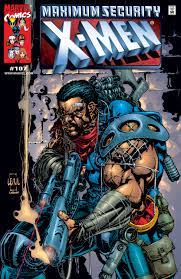 X-MEN vol 2 #107
X-MEN vol 2 #107
“On the Yard!”
by Chris Claremont, Leinil Francis Yu, Mark Morales, Scott Elmer & Liquid!
October 2000
This is part of the Maximum Security crossover, in which alien races try to turn Earth into an intergalactic prison colony, meaning that obscure alien villains can appear in tie-ins. There was a time when the X-books got to sit this sort of thing out, but 2000 was not that time. Wolverine has a one panel cameo fighting some aliens in a flashback in Avengers vol 3 #35, but this issue is his first proper appearance in the crossover – though he’s just making up the numbers with the X-Men.
Following a lead from Professor X’s former Skrull protégé Z’Cann, the X-Men try to take out the transport station on Ellis Island where new aliens are arriving. Wolverine gets knocked out early in the fight. Eventually Rogue realises that they’re not meant to destroy the station, but to secure it so that Bishop can use it to return to Earth. This leads directly into…
X-MEN UNLIMITED vol 1 #29
“Renewed Acquaintances”
by Joe Pruett, Brett Booth, Sal Regla, Sandu Florea & Joe Rosas
November 2000
The X-Men escape Ellis Island with Bishop. Then they team up with Warbird and Goliath (Hank Pym) to fight Ronan the Accuser, who is trying to terraform Earth into a new Ego the Living Planet. They retrieve some data that’s vital to the wider crossover. It’s mainly a Rogue and Warbird story.
MAXIMUM SECURITY #3
3-issue miniseries
by Kurt Busiek, Jerry Ordway, Will Blyberg, Mark McKenna, Paul Ryan, Jason Wright & Tom Smith
November 2000
Wolverine is among a crowd of heroes fighting the Ruul – disguised Kree who are behind the whole prison scheme. He’s also in a crowd fighting Ronan. He doesn’t get much to do here, but it is his first encounter with Silverclaw (Maria Santiago), Triathlon (Delroy Garrett Jr), Jack of Hearts (Jack Hart) and a bunch of absolute nonentities like the Winter Guard member Powersurge (Ilarion Ramskov), Mercurio, the Power Platoon, Geometer and the Blood Brothers. It’s also his first meeting with Chris Bradley as Bolt, who is now a member of the New Warriors.
SENTRY vol 1 #4
5-issue miniseries
by Paul Jenkins, Jae Lee & Jose Villarrubia
October 2000
Wolverine has a brief cameo at the X-Men Mansion when Professor X is telepathically contacted by the Sentry (Robert Reynolds).
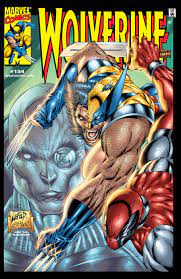 WOLVERINE vol 2 #154-155
WOLVERINE vol 2 #154-155
“All Along the Watchtower”
by Rob Liefeld, Eric Stephenson, Norm Rapmund & Digital Broome
July & September 2000
Meanwhile, back at Wolverine’s solo title, it’s time for more fill-ins!
After escaping an ambush in a bar, Wolverine is kidnapped by Deadpool and the mercenary group the Scourge – Pigskin, Vance Rebus, Deadeye Dick, Mega Max, Mini Max and Reckless Eric. They’ve been hired by the Watchtower, whose Administrator wants to copy Wolverine’s healing factor and use it to “heal a sick world”. (Deadpool is here because the Watchtower offered to use Wolverine’s healing factor to cure Siryn, who lost her powers in X-Force vol 1 #91. Surprisingly, they actually do it.)
Wolverine is rescued by Geronimo Crowe, Cargo, Hardwire and Shooter and declares that he will bring the Watchtower down. An absolute mess, but Liefeld keeps referencing the story in his later X-books work, so apparently he’s fond of it.
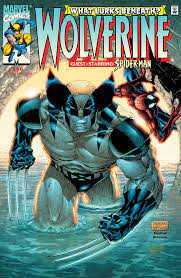 WOLVERINE vol 2 #156-157
WOLVERINE vol 2 #156-157
“Going Underground” / “Right Underneath It”
by Rob Liefeld, Eric Stephenson, Ian Churchill & Norm Rapmund
September & October 2000
A serial killer is abducting random people to the subway tunnels and killing them. Wolverine investigates, alongside Spider-Man and police officer Tara Curson, neither of whom contributes much to the plot. The killer is Fugue, a dim-witted member of a splinter group of Morlocks led by Carver. Wolverine challenges Carver to a duel under Morlock law, but Carver has indestructible skin, protecting him from Wolverine’s claws. So Wolverine takes his eye out. Fugue tries to help, but falls into a chasm, and Carver dives after him. The Mole Man, who was feuding with Carver’s Morlocks, buries them both underground. Mostly memorable for its remarkably honest closing line: “Could we have had more closure – a more definitive resolution? Maybe, but this’ll do.” Feel that deadline! (As for Carver, he remained a one-off character until 2022, when he resurfaced in Marauders Annual #1.)
From here, we enter the Frank Tieri run. As revealed in flashback in Wolverine vol 2 #166, the revived Weapon X Project reactivate Logan’s mental implants at this point, and bring him back under their control. At first, they use him to carry out tracking missions without his knowledge, locating expendable former Project members, but not actually doing anything to them. Logan has dreams about this, but he misinterprets them as something to do wtih his brainwashing by Apocalypse back at the start of the year. According to Wolverine Annual 2000, Wolverine is also attacking Apocalypse’s safehouses around this time, but isn’t really achieving anything.
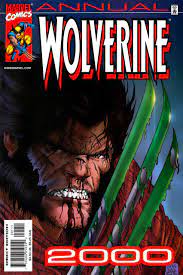 WOLVERINE ANNUAL 2000
WOLVERINE ANNUAL 2000
“Family”
by Frank Tieri, Jorge Santamaria, Nathan Messengill & Hi-Fi Design
November 2000
Alien bounty hunter Tyrus Krill enlists Logan’s help against a group of particularly vicious Brood who, he says, kill for pleasure rather than reproduction, and are considered criminals even by other Brood. What’s more, they were responsible for the death of his family. Fortunately, Krill has tailor made equipment to destroy them with.
There’s a twist: Krill is also infected, and is trying to resist his transformation until he has wiped out the cell, who actually are the rest of his family. All the Brood, including Krill himself, are killed, and so the family is finally reunited in death. The storytelling is a bit stodgy but the concept is perfectly decent.
Tieri makes some play of the fact that Wolverine is meant to be getting over his transformation into Death, something that was set up at the end of that storyline, but which had been completely ignored until this point. To his credit, Tieri at least tries to get something out of it, even if it’s mainly in the form of misdirection.
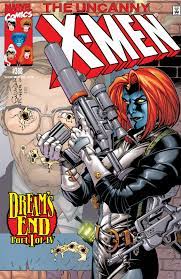 UNCANNY X-MEN vol 1 #388
UNCANNY X-MEN vol 1 #388
“Dream’s End, part 1 of 4”
by Chris Claremont, Salvador Larroca, Art Thibert, Lary Stucker & Richard Isanove
November 2000
Rogue’s powers are out of control, with powers that she’s absorbed before manifesting almost at random. Wolverine is the trusted confidant who helps her come to terms with it. Later, the two of them and Bishop pursue Mystique to Muir Island, but a massive explosion rocks the island as they approach.
This is one of two plot strands in “Dream’s End”; the other is about an attempted assassination of Senator Kelly, and doesn’t concern Wolverine at all. So we skip over part two of this crossover entirely.
BISHOP: THE LAST X-MAN #16
“Dream’s End, part 3 of 4”
by Scott Lobdell, Joe Pruett, Thomas Derenick, Todd Massengill, “Team X” & Jason Wright
November 2000
Wolverine, Rogue, Bishop and Wolfsbane fight Mystique, Toad and Sabretooth, and discover a mortally injured Moira MacTaggert, who has finally figured out a cure for the Legacy Virus. House of X #2 will retcon this story, revealing that Moira is faking her own death and that the Moira seen in this story is a golem, whatever that means.
X-MEN vol 2 #108
“Dream’s End, part 4 of 4”
by Chris Claremont, Leinil Francis Yu, Brett Booth, Mark Morales, Scott Elmer & Liquid!
November 2000
For some unfathomable reason, the X-Men fly Moira across the Atlantic to get her to the X-Men Mansion rather than just taking her to a hospital on mainland Scotland. They also take Mystique prisoner, and Wolverine toys with killing her. Moira dies on the flight, but Professor X and Jean Grey telepathically retrieve the cure from her mind first.
Naturally, Wolverine attends Moira’s funeral, which is shown in a flashback in Uncanny X-Men vol 1 #389.
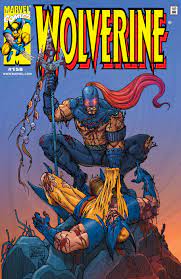 WOLVERINE vol 2 #158
WOLVERINE vol 2 #158
“Manhunt”
by Joe Pruett, Sunny Lee, Harry Candelario & Hi-Fi Design
November 2000
Yet another fill-in. Maximillian Zaran, a villain from Master of Kung Fu, lures Wolverine to his private island by kidnapping Amiko. Zaran plans to hunt and kill Wolverine in order to prove his skill to crimelord Shinji Kuzaki. Just to be on the safe side, he poisons Wolverine before setting him loose on the island, but Wolverine still beats Zaran with little difficulty. Amiko persuades Wolverine to spare Kuzaki, who privately vows revenge – but it’s a fill-in story, so we’ll never hear from him again.
UNCANNY X-MEN vol 1 #389
“The Good Shepherd”
by Chris Claremont, Salvador Larroca, Art Thibert & Hi-Fi Design
December 2000
This is Claremont’s final issue of Uncanny X-Men. That didn’t last long, did it? Wolverine only appears in subplots: Kitty Pryde goes missing, leaving a letter which explains that she is investigating Destiny’s diaries; and Cecilia Reyes suffers from withdrawal symptoms after being exposed to the highly addictive drug Rave.
With that, we arrive at the first Frank Tieri arc – but it’s a multipart story that runs into 2001. So we’ll cover it next time, as the Quesada/Jemas era really starts to take hold at Marvel.

I think Hickman got the term “golem” from a book you’ll cover in the next entry, the 2001 New X-Men Annual. In that story, the Chinese mutant Ao Jun is said to be able to produce “golems,” which are basically pseudo-clones made of shed skin flakes. So presumably this Moira is something similar, and Hickman liked Morrison’s run enough to borrow Morrison’s idiosyncratic use of the term “golem.”
I can feel Paul’s increasing disgust and weariness with the quality of X-stories during this period…
And yeah, not too long ago I found myself reflecting on the similarity between when the High Evolutionary took away every mutant’s powers, and when Wanda did it, and the vastly different reactions/repercussions/aftermaths… in one case it’s all “eh, no powers, cool” with the X-Men mostly scattering within days, before “cool, back to business as usual.” In the other… a decade of trauma.
We won’t actually get to the Morrison stories next time, since even though they came out in 2001, the timelines get increasingly haywire during the Quesada/Jemas era – lots of lengthy storylines with no gaps and little co-ordination result in books getting miles out of synch with one another.
“Nothing will come of that.”
More or less the working thesis of the X-books from about 1995-2001. Endless, endless storylines which set up things that never go anywhere.
This is right around the point where I got back into the X-books again and started collecting again, more or less picking up much of the line.
Claremont’s Revolution stuff is indeed dire. The Neo don’t work at all and he seems to be laying the groundwork for some long-running storylines, none of which go anywhere at all and he obviously got cut off before he could take it anywhere.
The Steve Skroce run is indeed brilliant and by far the most interesting thing Wolverine’s solo book had done since Ellis’ Not Dead Yet several years earlier.
I’ve got a huge soft spot for Frank Tieri’s run. It was the first book I started regularly reading again at the time and I got to know him on the old X-Fan boards around the time. He even ended up using my name (as well as a few other members from the forums) in his Wolverine/Deadpool/Weapon X run.
“I can feel Paul’s increasing disgust and weariness with the quality of X-stories during this period…”
It’s the best. “If you say so, Kitty!” made me laugh out loud.
“Hey, random black guy, I don’t like it when you call me ‘mutie’ so is it OK if I call you the n-word? That’s like the same thing, right?”
“If you say so, Kitty.”
There might be… something… you could do with the Neo as a concept that isn’t just terrible? Like, for all that Earth-616 is kind of analogous to real life with cities in the same places, it has a tendency for an awful lot of hidden societies with superpowers. The Eternals, Deviants, Atlanteans, Asgardians, Inhumans, Mutants, I guess the Neo, the cosmic potential the Rick Jones used a few times, etc etc etc. Maybe it could be like the episode of Star Trek TNG where it was revealed that all the alien races came from one source, or would that just be stupid? I guess there’s only so many times you can explain the existence of these entities as Celestial experiments before it becomes redundant.
Also Claremont surely saw The Matrix in 1999, and he goes and names his new plaything “The Neo” for god’s sake.
The one interesting outlier of the Revolution period is that it’s the first time that Claremont handles Bishop, who goes on to be a staple of X-Treme X-Men and Claremont’s third run. Everything else about Revolution goes nowhere but Claremont’s take on Bishop – playing up the idea that he was a cop – is something he lands on very quickly. Early Bishop stories tended to play up his willingness to be worryingly extreme, whereas Claremont’s is coolly professional. To some extent, that’s basically the version we have now.
As for Wolverine, this is just a dismal period for him. Just fill-ins, editorial mandates and ill-fated new directions. It was a terrible decision to basically nuke his supporting cast. I think this period partially explains why I give more slack to the current Percy run than most – I like Wolverine better when he has a definable supporting cast and recurring enemies, as in the Claremont and Hama runs. I don’t like it when the other X-Men are his only friends.
It sounds like someone wants to see the return of Xorr the God Jewel.
“Also Claremont surely saw The Matrix in 1999, and he goes and names his new plaything “The Neo” for god’s sake.”
That would make sense if he decided to name the new Thunderbird “Neo” instead, not a whole group of “post-mutant” villains. The Neo isn’t a good name, but at least it vaguely has something to do with what they represent.
The 1999/2000 period might be the most unknown to me (post-pre-Claremont X-Men, at least – I’ve only read a few Silver Age issues).
And, well, reading this doesn’t particularly make me want to remedy that anytime soon. Still, brilliant write-up, I’m enjoying it a lot.
After the chaos of the past few years, I give Revolution credit for at least trying to go be the books a stable direction while moving characters forward a bit.
It’s not good, but it tried.
Also it kind of feels like the last “big old team” period which I miss.
Is Cable holding a big feather in that first image? And if so, why?
It’s his psychic amplifying spear, the Psimitar.
The name is a joke on scimitar.
Which is a sword.
So it’s a dumb name.
It also looks like a tickle feather in that picture
“Is Cable holding a big feather in that first image?”
It’s supposed to be a spear, established before Liefeld came on the book: https://static.wikia.nocookie.net/xmenrebirth/images/6/62/CableVol167.jpg/revision/latest?cb=20110919172403
But it’s Liefeld. So the answer to your question is, apparently, yes.
Wolverine: Blood Debt is a weird one, and I don’t mean that in a bad way.
It was, I think, Steve Skroce’s last Marvel work (I think he’s only started doing covers again this year?) before going on to storyboard the Matrix sequels, so it’s kind of the pinnacle of his comics art before he went off into Doc Frankenstein at Burleyman, which was . . . odd.
It’s also the only work he’s written at Marvel, if I recall.
It’s sort of a generic “Wolverine in Japan fighting ninjas” story, but a really pretty one, and one of the first graphic novels Marvel published under what became its current graphic novel production scheme (that is, self-contained story arcs, glossy pages, etc.).
It’s the kind of thing Marvel would be regularly publishing a decade later, but a curio for 2000.
Man Paul’s original review for Cable #75 is so good. All those years building up some epic Cable vs Apocalypse conflict for nothing, lol.
I get the sense that “Revolution” was less succesful with the core X-books than with the segment that was dubbed “Counter X” at the time. If nothing else, X-Man, X-Force and Generation X seem to have developed a bit of a renewed senses of direction and identity at that time. Which may have led to the eventual cancellation of some of those books, I suppose, but that was not really avoidable IMO. The whole line was too bloated and too weakly guided by any true editorial vision.
The Twelve was a bigger disappointment than “who is the X-Traitor?”
Wow. I forgot how short Claremont’s return was on these books. Did the Neo move over to extreme? I feel they were being set up as the next generation of X-men. This run started Claremont’s rut of psychic slaver stuff?
Oh, wasn’t this savage Kitty who acted as a ninja and had one of Wolverine’s claws as a weapon? Ahh, fun time.
Reading a mention of the Jenkins/Lee Sentry series was jarring. It was a much more modern book (for the times) than any of the other comics from 2000. Claremont and Liefeld were well past their prime, and most of the rest of this was either editorially-mandated slop or bad fill-ins. The only exception is the Skroce Wolverine story. Like the book or not, the postmodern storytelling and singular art in Sentry (and most of the Marvel Knights comics) were More forwards thinking than anything that came out of the X alone until the following year.
Thomas-No. After Claremont left, they were unceremoniously killed off by a later writer in an attempt to build up how powerful this next big threat was to the X-Men.
I think Claremont’s obsession with psychic slavers dates back to his start in comics.
The Neo last a grand total of one issue post-Claremont. Claremont’s out with X-Men #109, and then in #110, Magneto shows up, demands fealty from the Neo, kills two easily and the others submit. And then presumably decamp to Genosha, where he was in charge of the time, just in time for the Cassandra Nova’s Sentinels to kill everyone. They’re presumably but not officially all dead, because who cares, it’s the Neo.
Claremont’s always had a thing for mind control and slavery storylines. I think the tipping point for some readers, myself included, was late-stage X-Treme X-Men where he had a protracted storyline about Elias Bogan, a telepath who’s probably the Shadow King but never officially established as such, which means we have a one-dimensional mind control baddie and there’s no real payoff. And then The Arena, which is all of Claremont’s fetishes combined into a single arc. Bonus contender is his third Uncanny run, which goes to that well repeatedly.
It was already plenty clear during the #110s of Uncanny that Claremont loves mental slavery plots. I noticed that by the time that Sauron first met Wolverine.
In less than ten issues he brought Mesmero back and had the whole team forced to perform in a circus in somewhat degrading roles, then had them spend some time in the Savage Land to face Sauron who mind controls Wolverine. Not too long after they face Proteus, who literally possesses the bodies of his opponents. And we get bits and pieces of Jason Wyngarde shaping Jean’s mind from the inside in the meantime.
Claremont’s over-reliance on mind-control and slavery stories/plot-devices was obvious right from the start of his initial Uncanny run.
To wit :
UX #94-95 : Claremont adds a new member to the Ani-Men with hypnosis powers.
UX #97 (+#105) : Havok & Polaris get mind-controlled (somehow) by Erik the Red.
UX #111 : Mesmero turns the X-Men into a circus.
UX #112-113 : Magneto indulges in his infantilism fetish against the captured X-Men
UX #115 : Sauron mind-controls Wolverine into fighting the X-Men.
UX #117 : Introduction of the Shadow King.
UX #123-124 : Arcade somehow brainwashes Colossus into “the Proletarian”
UX #125-134 : Mastermind slowly seduces Jean, leading to the Dark Phoenix saga.
Then there’s the Brood saga as a whole, the Magik mini, the Kitty Pryde & Wolverine mini, a lot of New Mutants, everything involving Rachel…
My personal breaking point was the Australian era, with the new Brood storyline, Inferno and its leadup, Nanny brainwashing half the team for Storm’s “death” issue, the Savage Land adventure in #250, Psylocke forcing everyone through the Siege Perilous… (quickly followed by the Ninja Psylocke story and LOTS of Shadow King content).
“infantilism fetish”
That certainly throws a different light on the X-Babies.
And it seems like something that Claremont and Byrne have in common. If you’ve been reading Byrne’s “X-Men fanfic” on his official site, there’s a whole subplot about Jean being an adult with the mind of a child. It goes on for…forever?
“Liefeld [was[ well past [his] prime”
Oof, it’s true, though. By the end of 2000, Jim Lee hadn’t even started his huge-selling runs on Batman, All Star Batman, or Justice League. Meanwhile, (almost?) all of his other partners in crime who founded Image had peaked long before.
“Claremont’s over-reliance on mind-control and slavery stories/plot-devices”
Are we sure it’s a fetish thing and not just laziness? I mean, it’s a really easy way to take multiple team members off the board so that the story can focus on just a few at a time, and it simultaneously strengthens the enemy’s ranks and makes them more of a challenge to overcome.
A lot of mind controlled people in the stories start wearing bondage gear as everyday clothes, and speaking and acting in a much more sexual manner. I’m sure sometimes it was just a lazy plot device, but there was definitely kink involved quite often.
He sure seems to like mind control and dominatrixes.
And “good girls gone bad.”
And bad girls gone good, or at least bad girls gone sympathetic. It’s harder to come up with the female villains Claremont didn’t make sympathetic in some way.
The original review of Cable issue 75 is another x-axis classic. Starts off something like ‘the credited writer didn’t write it, and the artist’s father just died. In the circumstances neither can be expected to produce their best work’
Liefeld has actually improved by leaps and bounds since his 1990s work. If he ever peaked, it was at some time closer to 2010 than to 2000.
His work in last November’s X-Force: Killshot Anniversary Special was… remarkably mediocre, shall we say. So was 2019’s “Major X”.
Very, very lackluster, eminently forgettable pencils. Nothing to write home about, not by a long shot.
For him that is an impressive achievement. He is now solidly amateurish.
Does anyone remember that old conversation between Claremont and Alan Moore published in some fanzine? Claremont said that he feels the need to put the X-Men against entire teams of villains because if it’s just one or two people, the villains feel like the underdogs. So at least that’s the impetus.
Whatever other problems there were with the Neo, I’ll maintain one of the biggest was their generic design. Like, do they really have much less personality than, say, most of the original Marauders? But the Marauders had those memorable, distinctive looks and that goes a long way.
It’s weird that Krakoa isn’t angrier at the High Evolutionary. Not only did he depower everyone and somehow kill a bunch of hidden mutants, he’s the one who gave Wanda her powers. That’s two depowering events to lay at his feet.
Claremont is rumored to have ghost-written some of the X-Men stories leading up to Revolution. Much of the era from 1998-Revolution feels like Claremont might be playing shadow-showrunner. He was back at Marvel in an editorial capacity and at one stage was going to return to the x-books in ‘98, with him writing one x-title and Lobdell, before he quit, writing the other. But contractual negotiations delayed his official return.
Once Claremont did officially return, the editors apparently insisted that he make new villains for the first few arcs, which is why we got the Neo. Claremont’s post-1991 work has never risen to the heights of his classic run, but the Revolution setup is pretty unsuccessful even by the standards of his later work. What the fans wanted was classic Claremont, but what they got with Revolution was meant to be radically new, as the name suggests. Big misstep.
On the *ahem* themes in Claremont’s work, isn’t there a famous story of Marvel editorial always mockingly making a big deal of getting him a cushion to seat on when he came into the office?
“What the fans wanted was classic Claremont”
This suggests that Claremont didn’t want to create new characters, and that he had the writing talent to write good stories if he hadn’t created new characters.
I mean, the last few years of his original Uncanny run demonstrates that he wasn’t much interested in telling “classic Claremont stories” anymore anyway.
I missed several key (or not so key) issues of The Twelve when they were coming out – I used to go to the comics shop on a Friday, and they’d already gone. Still not got Wolverine 145 where he gets the adamantium back, but only last year I finally found a back issue of Cable 75. Missed a couple of the Ages of Apocalypse issues as well, but I wasn’t bothered about those as even at the time I was distinctly underwhelmed by how the story changed to pointless imaginary realities.